The “Windows Has Been Shutdown” is classified as misleading ‘ad’ page. This webpage is made to trick you into calling a fake Microsoft Support Service. It can open fake alerts and warning or redirect your internet browser on other misleading webpages. If you are seeing this intrusive webpage then it is possible that an adware (also known as ‘ad-supported’ software) was installed on your PC system. As a result of the adware infection, your web-browser will be full of advertisements (pop-ups, banners, in-text links, offers to install an undesired applications) and your computer will be slower and slower.
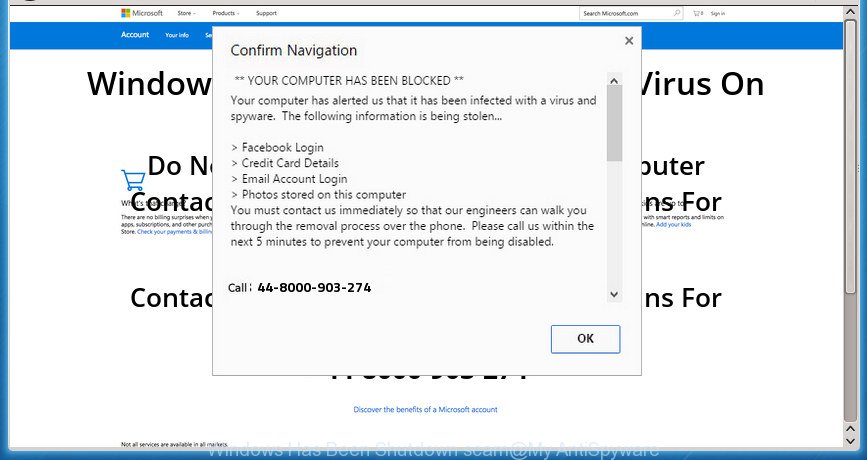
The “Windows Has Been Shutdown” is a misleading advertising as shown on the example above
The ‘ad supported’ software which developed to show misleading “Windows Has Been Shutdown” pop-up warnings within your web-browser, is the part of the software that is used as an online promotional tool. It is created with the sole purpose to open dozens of pop-up ads, and thus to promote the goods and services in an open internet browser window. Moreover, the adware can substitute the legitimate advertising banners on misleading or even banners that can offer to visit malicious web-pages. The reason is simple, many advertisers agree on any ways to attract users to their web sites, so the makers of adware, often forcing users to click on an advertising link. For each click on a link, the makers of the adware receive income.
The malicious apps from the adware family that modifies the settings of browsers usually affects only the Internet Explorer, Mozilla Firefox, Google Chrome and Microsoft Edge. However, possible situations, when any other browsers will be hijacked too. The adware may modify the Target property of a internet browser’s shortcut, so every time you run the web-browser, instead of your start page, you’ll see the intrusive “Windows Has Been Shutdown” site.
We strongly suggest that you perform the few simple steps below that will help you to delete “Windows Has Been Shutdown” fake alerts using the standard features of Windows and some proven free applications.
Remove “Windows Has Been Shutdown” pop-up warnings
In order to remove “Windows Has Been Shutdown” popup from the Edge, Chrome, Internet Explorer and FF, you need to reset the internet browser settings. Additionally, you should look up for other suspicious entries, such as files, applications, internet browser extensions and shortcut files. However, if you want to delete “Windows Has Been Shutdown” fake alerts easily, you should use reputable anti-malware tool and let it do the job for you.
To remove “Windows Has Been Shutdown”, use the following steps:
- How to remove “Windows Has Been Shutdown” fake alerts without any software
- Deleting the “Windows Has Been Shutdown”, check the list of installed programs first
- Remove “Windows Has Been Shutdown” popup from Chrome
- Get rid of “Windows Has Been Shutdown” popup from Mozilla Firefox
- Get rid of “Windows Has Been Shutdown” pop up warnings from IE
- Disinfect the internet browser’s shortcuts to get rid of “Windows Has Been Shutdown” redirect
- Delete unwanted Scheduled Tasks
- “Windows Has Been Shutdown” pop-up scam automatic removal
- Use AdBlocker to stop “Windows Has Been Shutdown” and stay safe online
- How to avoid installation of “Windows Has Been Shutdown” fake alerts
- Finish words
How to remove “Windows Has Been Shutdown” fake alerts without any software
Most common ad supported software may be removed without any antivirus programs. The manual ad-supported software removal is guidance that will teach you how to remove the “Windows Has Been Shutdown” pop-up warnings.
Deleting the “Windows Has Been Shutdown”, check the list of installed programs first
In order to delete potentially unwanted software like this adware, open the Microsoft Windows Control Panel and click on “Uninstall a program”. Check the list of installed applications. For the ones you do not know, run an Internet search to see if they are ad supported software, browser hijacker or potentially unwanted applications. If yes, remove them off. Even if they are just a apps that you do not use, then uninstalling them off will increase your personal computer start up time and speed dramatically.
Make sure you have closed all internet browsers and other software. Press CTRL, ALT, DEL keys together to open the MS Windows Task Manager.

Click on the “Processes” tab, look for something questionable that is the adware that causes web browsers to show misleading “Windows Has Been Shutdown” pop up scam then right-click it and select “End Task” or “End Process” option. In most cases, malicious software masks itself to avoid detection by imitating legitimate Microsoft Windows processes. A process is particularly suspicious: it is taking up a lot of memory (despite the fact that you closed all of your programs), its name is not familiar to you (if you are in doubt, you can always check the application by doing a search for its name in Google, Yahoo or Bing).
Next, uninstall any unknown and suspicious apps from your Control panel.
Windows 10, 8.1, 8
Now, click the Windows button, type “Control panel” in search and press Enter. Choose “Programs and Features”, then “Uninstall a program”.
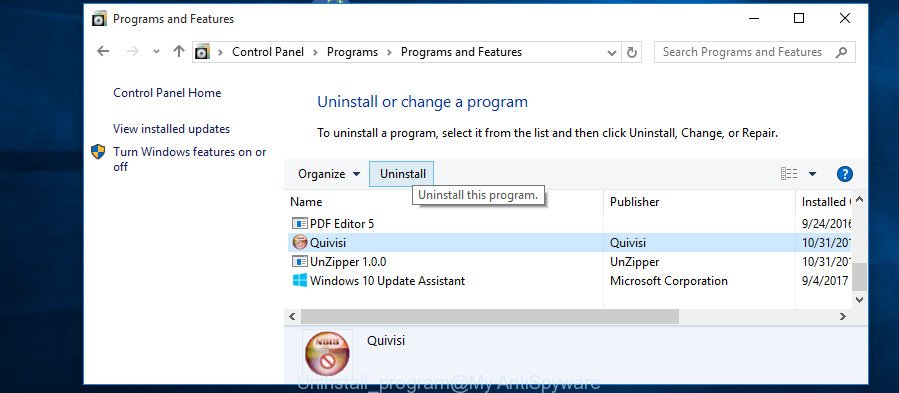
Look around the entire list of applications installed on your computer. Most probably, one of them is the adware which developed to show misleading “Windows Has Been Shutdown” popup scam within your internet browser. Choose the questionable application or the application that name is not familiar to you and uninstall it.
Windows Vista, 7
From the “Start” menu in Microsoft Windows, select “Control Panel”. Under the “Programs” icon, choose “Uninstall a program”.

Choose the suspicious or any unknown applications, then press “Uninstall/Change” button to delete this undesired application from your PC.
Windows XP
Click the “Start” button, select “Control Panel” option. Click on “Add/Remove Programs”.
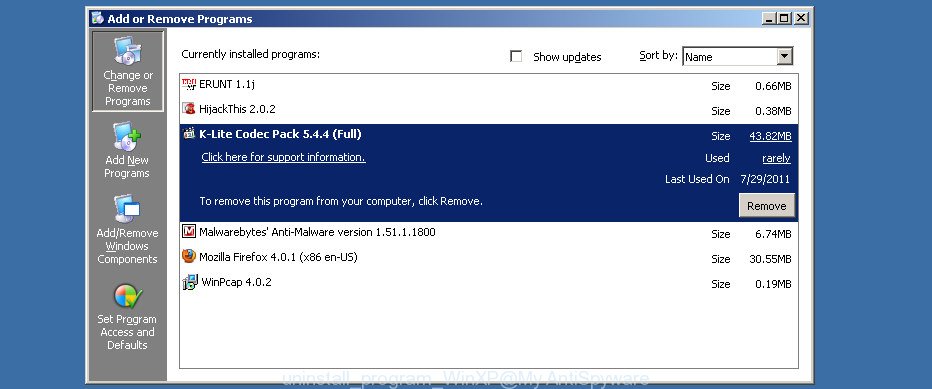
Choose an unwanted application, then click “Change/Remove” button. Follow the prompts.
Remove “Windows Has Been Shutdown” popup from Chrome
Reset Chrome settings is a easy way to get rid of the adware, harmful and adware extensions, as well as to restore the web browser’s startpage, newtab page and search provider that have been modified by ‘ad supported’ software which created to show misleading “Windows Has Been Shutdown” fake alerts within your web-browser.
Open the Google Chrome menu by clicking on the button in the form of three horizontal dotes (![]() ). It will display the drop-down menu. Choose More Tools, then click Extensions.
). It will display the drop-down menu. Choose More Tools, then click Extensions.
Carefully browse through the list of installed addons. If the list has the extension labeled with “Installed by enterprise policy” or “Installed by your administrator”, then complete the following guidance: Remove Google Chrome extensions installed by enterprise policy otherwise, just go to the step below.
Open the Chrome main menu again, click to “Settings” option.

Scroll down to the bottom of the page and click on the “Advanced” link. Now scroll down until the Reset settings section is visible, as shown in the figure below and click the “Reset settings to their original defaults” button.

Confirm your action, click the “Reset” button.
Get rid of “Windows Has Been Shutdown” popup from Mozilla Firefox
Resetting your FF is basic troubleshooting step for any issues with your web-browser program, including the redirect to “Windows Has Been Shutdown” webpage.
First, launch the FF and click ![]() button. It will open the drop-down menu on the right-part of the internet browser. Further, press the Help button (
button. It will open the drop-down menu on the right-part of the internet browser. Further, press the Help button (![]() ) as displayed below.
) as displayed below.

In the Help menu, select the “Troubleshooting Information” option. Another way to open the “Troubleshooting Information” screen – type “about:support” in the internet browser adress bar and press Enter. It will display the “Troubleshooting Information” page as shown below. In the upper-right corner of this screen, click the “Refresh Firefox” button.

It will display the confirmation prompt. Further, click the “Refresh Firefox” button. The Mozilla Firefox will begin a procedure to fix your problems that caused by the adware which shows misleading “Windows Has Been Shutdown” popup warnings on your PC system. After, it’s finished, click the “Finish” button.
Get rid of “Windows Has Been Shutdown” pop up warnings from IE
By resetting Microsoft Internet Explorer internet browser you restore your browser settings to its default state. This is first when troubleshooting problems that might have been caused by adware that causes internet browsers to show misleading “Windows Has Been Shutdown” pop-up.
First, launch the IE, click ![]() ) button. Next, press “Internet Options” as displayed on the screen below.
) button. Next, press “Internet Options” as displayed on the screen below.

In the “Internet Options” screen select the Advanced tab. Next, click Reset button. The IE will display the Reset Internet Explorer settings prompt. Select the “Delete personal settings” check box and press Reset button.

You will now need to reboot your machine for the changes to take effect. It will get rid of ‘ad supported’ software that causes web browsers to display misleading “Windows Has Been Shutdown” pop up scam, disable malicious and ad-supported web-browser’s extensions and restore the Internet Explorer’s settings like default search engine, newtab and homepage to default state.
Disinfect the internet browser’s shortcuts to get rid of “Windows Has Been Shutdown” redirect
Important to know, most anti-malware applications which are able to get rid of adware which cause misleading “Windows Has Been Shutdown” fake alerts to appear, but unable to search for and recover changed shortcuts. So, you need to fix the desktop shortcut files for your FF, IE, Chrome and Edge web browsers manually.
Open the properties of the web browser shortcut. Right click on the shortcut of affected web-browser and select the “Properties” option and it’ll display the properties of the shortcut file. Next, choose the “Shortcut” tab and have a look at the Target field as displayed in the figure below.
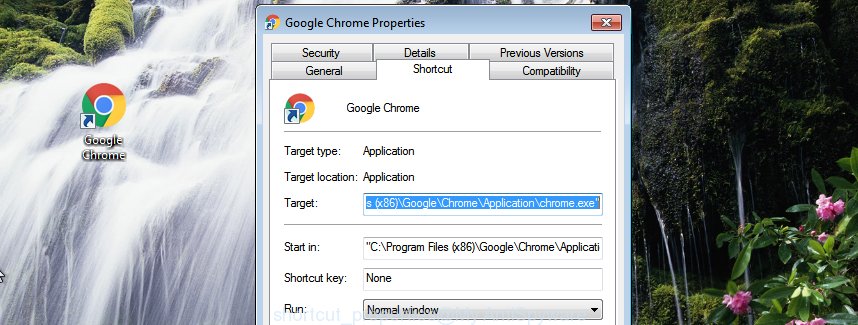
Normally, if the last word in the Target field is chrome.exe, iexplore.exe, firefox.exe. Be sure to pay attention to the extension, should be “exe”! All shortcuts that have been altered by ad supported software which causes misleading “Windows Has Been Shutdown” pop up on your browser, usually point to .bat, .cmd or .url files instead of .exe as displayed on the screen below

Another variant, an address has been added at the end of the line. In this case the Target field looks like …Application\chrome.exe” http://site.address as shown in the figure below.

In order to fix the infected shortcut file, you need to insert right path to the Target field or remove an address (if it has been added at the end). You can use the following information to fix your shortcut files that have been changed by ad supported software that displays misleading “Windows Has Been Shutdown” popup scam on your computer.
| Google Chrome | C:\Program Files (x86)\Google\Chrome\Application\chrome.exe |
| C:\Program Files\Google\Chrome\Application\chrome.exe | |
| FF | C:\Program Files\Mozilla Firefox\firefox.exe |
| Microsoft Internet Explorer | C:\Program Files (x86)\Internet Explorer\iexplore.exe |
| C:\Program Files\Internet Explorer\iexplore.exe | |
| Opera | C:\Program Files (x86)\Opera\launcher.exe |
| C:\Program Files\Opera\launcher.exe |
Once is finished, click OK to save changes. Repeat the step for all browsers which are redirected to the “Windows Has Been Shutdown” annoying web site.
Delete unwanted Scheduled Tasks
Once installed, the adware can add a task in to the Windows Task Scheduler Library. Due to this, every time when you launch your PC system, it will show “Windows Has Been Shutdown” intrusive webpage. So, you need to check the Task Scheduler Library and remove all harmful tasks which have been created by unwanted apps.
Press Windows and R keys on your keyboard at the same time. It will show a dialog box which called Run. In the text field, type “taskschd.msc” (without the quotes) and click OK. Task Scheduler window opens. In the left-hand side, click “Task Scheduler Library”, as displayed on the screen below.
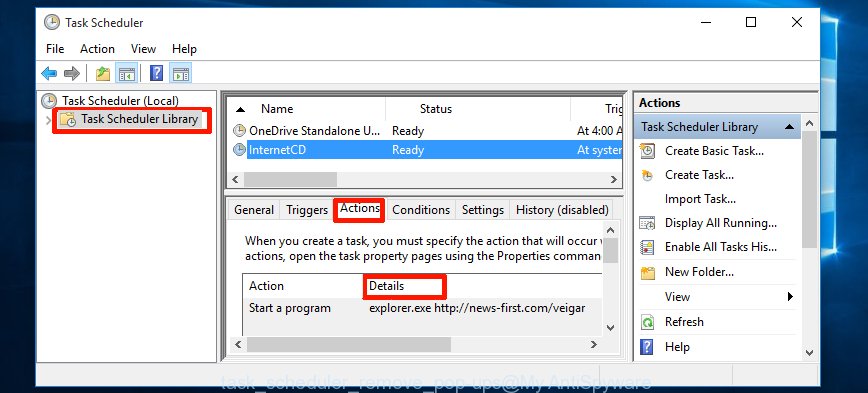
Task scheduler, list of tasks
In the middle part you will see a list of installed tasks. Select the first task, its properties will be show just below automatically. Next, click the Actions tab. Necessary to look at the text which is written under Details. Found something like “explorer.exe http://site.address” or “chrome.exe http://site.address” or “firefox.exe http://site.address”, then you need remove this task. If you are not sure that executes the task, then google it. If it is a component of the adware, then this task also should be removed.
Further press on it with the right mouse button and select Delete as displayed on the image below.

Task scheduler, delete a task
Repeat this step, if you have found a few tasks that have been created by malicious programs. Once is done, close the Task Scheduler window.
“Windows Has Been Shutdown” pop-up scam automatic removal
Manual removal steps does not always help to completely delete the ad supported software, as it’s not easy to identify and remove components of ad-supported software and all malicious files from hard disk. Therefore, it’s recommended that you use malicious software removal tool to completely get rid of “Windows Has Been Shutdown” off your browser. Several free malware removal tools are currently available that can be used against the ‘ad supported’ software. The optimum solution would be to run Zemana AntiMalware (ZAM), MalwareBytes Free and Hitman Pro.
How to remove “Windows Has Been Shutdown” popup scam with Zemana Anti-malware
We recommend using the Zemana Anti-malware that are completely clean your computer of the ad supported software. The tool is an advanced malware removal program designed by (c) Zemana lab. It is able to help you delete PUPs, hijackers, malware, toolbars, ransomware and ad-supported software that causes web-browsers to display misleading “Windows Has Been Shutdown” fake alerts.
Installing the Zemana Free is simple. First you will need to download Zemana Anti-Malware by clicking on the following link. Save it on your Desktop.
164720 downloads
Author: Zemana Ltd
Category: Security tools
Update: July 16, 2019
After downloading is done, close all programs and windows on your machine. Open a directory in which you saved it. Double-click on the icon that’s called Zemana.AntiMalware.Setup as shown in the following example.
![]()
When the setup starts, you will see the “Setup wizard” that will allow you set up Zemana Anti Malware (ZAM) on your PC system.

Once setup is done, you will see window like below.

Now click the “Scan” button to find ad supported software which cause misleading “Windows Has Been Shutdown” pop-up to appear. This task may take some time, so please be patient. When a malicious software, ad supported software or PUPs are found, the count of the security threats will change accordingly. Wait until the the scanning is finished.

After Zemana Free has completed scanning your system, Zemana Anti Malware will prepare a list of undesired and ad-supported software. You may remove items (move to Quarantine) by simply press “Next” button.

The Zemana Anti-Malware (ZAM) will remove adware that causes multiple misleading “Windows Has Been Shutdown” alerts and pop ups and move threats to the program’s quarantine.
Scan and clean your PC system of adware with HitmanPro
HitmanPro is a free program that made to remove malware, PUPs, browser hijackers and adware from your personal computer running Windows 10, 8, 7, XP (32-bit and 64-bit). It’ll help to identify and delete adware which shows misleading “Windows Has Been Shutdown” fake alerts on your computer, including its files, folders and registry keys.
Hitman Pro can be downloaded from the following link. Save it directly to your Windows Desktop.
Once the downloading process is finished, open the file location and double-click the Hitman Pro icon. It will run the Hitman Pro utility. If the User Account Control prompt will ask you want to run the program, click Yes button to continue.
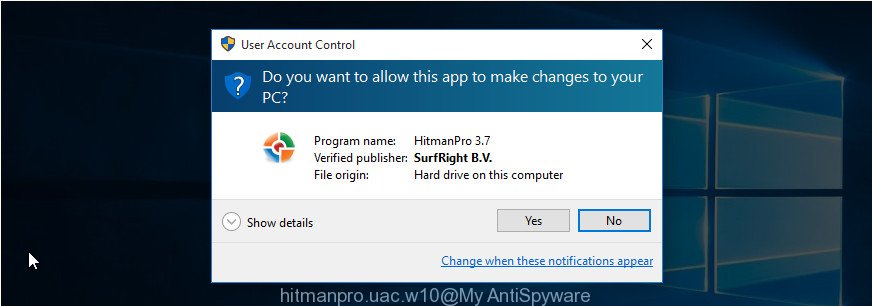
Next, press “Next” . HitmanPro program will scan through the whole computer for the adware that made to display misleading “Windows Has Been Shutdown” popup within your internet browser. This task can take quite a while, so please be patient. While the utility is checking, you may see number of objects and files has already scanned.
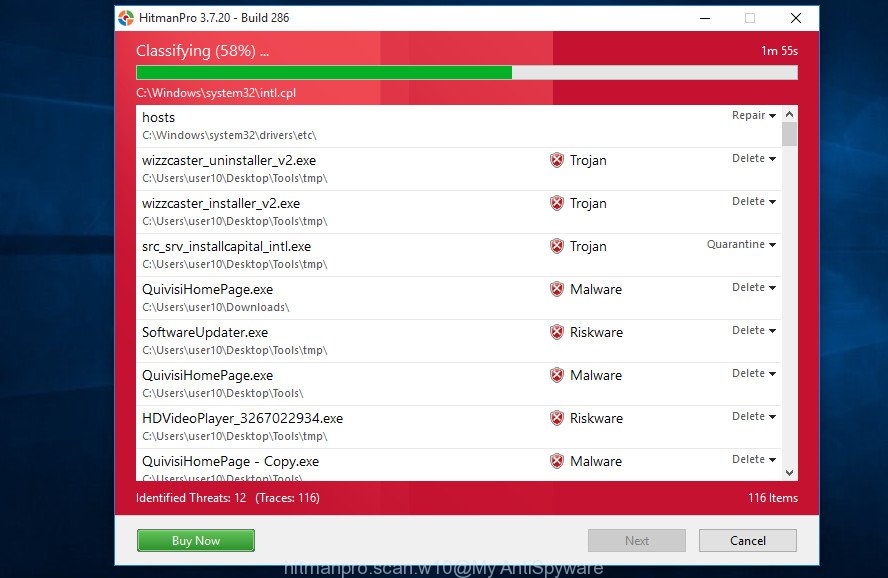
Once that process is finished, the results are displayed in the scan report as displayed in the following example.
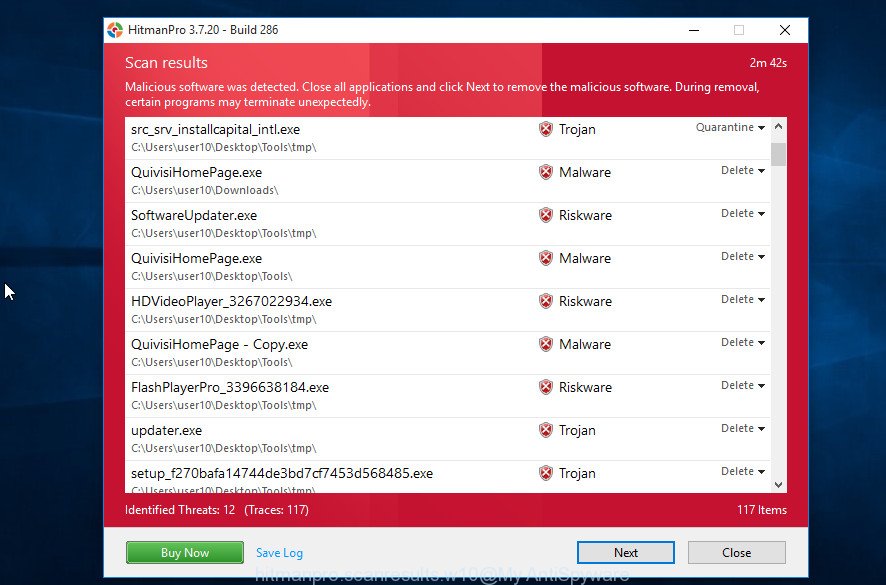
Make sure all threats have ‘checkmark’ and press “Next” button. It will show a dialog box, press the “Activate free license” button. The Hitman Pro will remove adware that causes multiple misleading “Windows Has Been Shutdown” alerts and pop-ups and add items to the Quarantine. Once disinfection is finished, the tool may ask you to reboot your personal computer.
How to automatically get rid of “Windows Has Been Shutdown” with Malwarebytes
Delete “Windows Has Been Shutdown” pop up scam manually is difficult and often the adware is not completely removed. Therefore, we suggest you to use the Malwarebytes Free which are completely clean your computer. Moreover, the free application will help you to get rid of malware, PUPs, toolbars and hijackers that your machine can be infected too.
Please go to the following link to download MalwareBytes Anti-Malware. Save it on your Microsoft Windows desktop.
326995 downloads
Author: Malwarebytes
Category: Security tools
Update: April 15, 2020
After the downloading process is done, close all applications and windows on your PC system. Double-click the install file called mb3-setup. If the “User Account Control” prompt pops up as shown in the following example, click the “Yes” button.
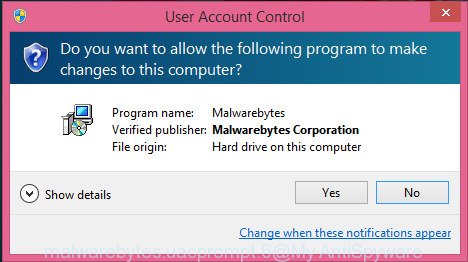
It will open the “Setup wizard” which will help you set up MalwareBytes on your machine. Follow the prompts and don’t make any changes to default settings.
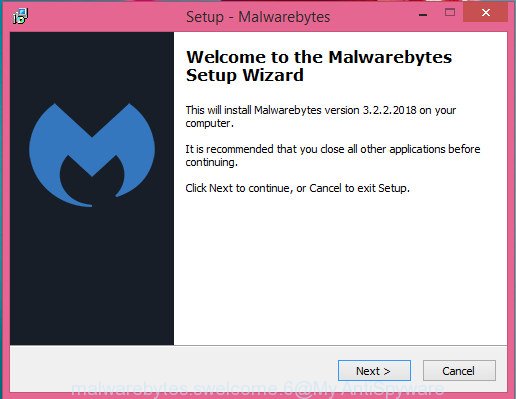
Once install is done successfully, click Finish button. MalwareBytes AntiMalware will automatically start and you can see its main screen as displayed on the image below.
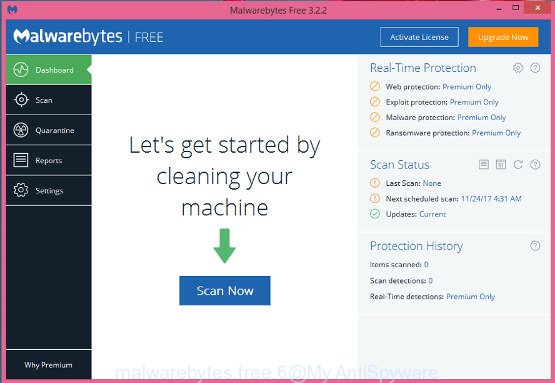
Now click the “Scan Now” button to perform a system scan with this tool for the adware that cause misleading “Windows Has Been Shutdown” popup scam to appear. Depending on your computer, the scan can take anywhere from a few minutes to close to an hour. While the MalwareBytes utility is checking, you can see number of objects it has identified as being infected by malicious software.
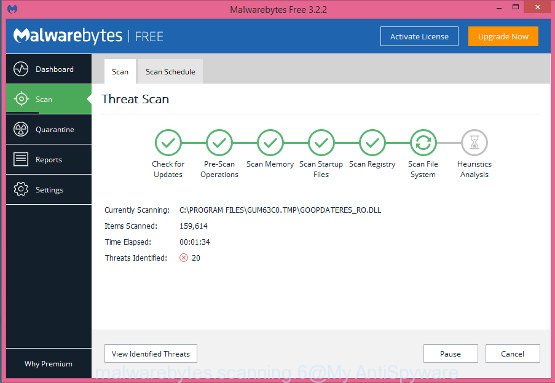
When MalwareBytes completes the scan, MalwareBytes Free will show a scan report. All detected threats will be marked. You can remove them all by simply click “Quarantine Selected” button. The MalwareBytes AntiMalware will delete adware which designed to show misleading “Windows Has Been Shutdown” popup scam within your internet browser and move threats to the program’s quarantine. Once the task is finished, you may be prompted to reboot the machine.
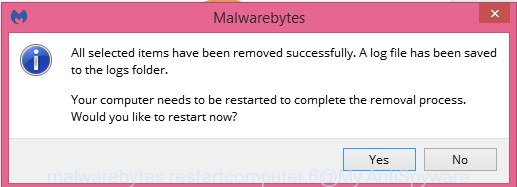
We recommend you look at the following video, which completely explains the process of using the MalwareBytes to get rid of ad-supported software, hijacker and other malicious software.
Use AdBlocker to stop “Windows Has Been Shutdown” and stay safe online
To put it simply, you need to use an ad-blocker tool (AdGuard, for example). It’ll stop and protect you from all unwanted web sites like “Windows Has Been Shutdown”, ads and pop ups. To be able to do that, the adblocker program uses a list of filters. Each filter is a rule that describes a malicious web-page, an advertising content, a banner and others. The ad-blocking program automatically uses these filters, depending on the websites you are visiting.
- Download AdGuard from the link below. Save it on your Windows desktop.
Adguard download
26824 downloads
Version: 6.4
Author: © Adguard
Category: Security tools
Update: November 15, 2018
- Once downloading is finished, start the downloaded file. You will see the “Setup Wizard” program window. Follow the prompts.
- Once the install is finished, press “Skip” to close the install application and use the default settings, or click “Get Started” to see an quick tutorial that will allow you get to know AdGuard better.
- In most cases, the default settings are enough and you do not need to change anything. Each time, when you start your PC, AdGuard will start automatically and stop popups, “Windows Has Been Shutdown” redirect, as well as other malicious or misleading web-pages. For an overview of all the features of the program, or to change its settings you can simply double-click on the icon called AdGuard, that is located on your desktop.
How to avoid installation of “Windows Has Been Shutdown” fake alerts
Most often the ad-supported software come together with various freeware, as a bonus. Therefore it is very important at the stage of installing software downloaded from the Internet carefully review the Terms of use and the License agreement, as well as to always select the Advanced, Custom or Manual setup method. In this mode, you can turn off all unwanted add-ons, including this adware, which will be installed along with the desired program. Of course, if you uninstall the freeware from your system, the adware will not be removed automatically. Therefore, in order to get rid of “Windows Has Been Shutdown” fake alerts from the IE, Google Chrome, MS Edge and FF you need to follow the steps above.
Finish words
After completing the instructions outlined above, your PC system should be clean from this ad supported software and other malicious software. The Google Chrome, Firefox, MS Edge and Microsoft Internet Explorer will no longer show annoying “Windows Has Been Shutdown” web-site when you browse the Internet. Unfortunately, if the steps does not help you, then you have caught a new adware, and then the best way – ask for help.
Please start a new thread by using the “New Topic” button in the Spyware Removal forum. When posting your HJT log, try to give us some details about your problems, so we can try to help you more accurately. Wait for one of our trained “Security Team” or Site Administrator to provide you with knowledgeable assistance tailored to your problem with the unwanted “Windows Has Been Shutdown” pop-up.



















